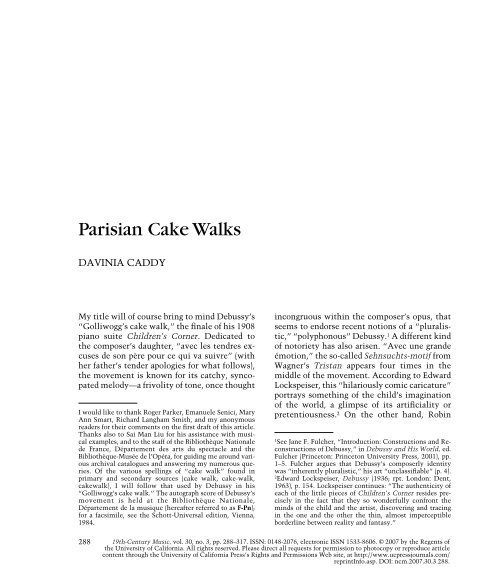Parisian Cake Walks.pdf - ResearchSpace@Auckland
Parisian Cake Walks.pdf - ResearchSpace@Auckland
Parisian Cake Walks.pdf - ResearchSpace@Auckland
You also want an ePaper? Increase the reach of your titles
YUMPU automatically turns print PDFs into web optimized ePapers that Google loves.
19TH<br />
CENTURY<br />
MUSIC<br />
<strong>Parisian</strong> <strong>Cake</strong> <strong>Walks</strong><br />
DAVINIA CADDY<br />
My title will of course bring to mind Debussy’s<br />
“Golliwogg’s cake walk,” the finale of his 1908<br />
piano suite Children’s Corner. Dedicated to<br />
the composer’s daughter, “avec les tendres excuses<br />
de son père pour ce qui va suivre” (with<br />
her father’s tender apologies for what follows),<br />
the movement is known for its catchy, syncopated<br />
melody—a frivolity of tone, once thought<br />
I would like to thank Roger Parker, Emanuele Senici, Mary<br />
Ann Smart, Richard Langham Smith, and my anonymous<br />
readers for their comments on the first draft of this article.<br />
Thanks also to Sai Man Liu for his assistance with musical<br />
examples, and to the staff of the Bibliothèque Nationale<br />
de France, Département des arts du spectacle and the<br />
Bibliothèque-Musée de l’Opéra, for guiding me around various<br />
archival catalogues and answering my numerous queries.<br />
Of the various spellings of “cake walk” found in<br />
primary and secondary sources (cake walk, cake-walk,<br />
cakewalk), I will follow that used by Debussy in his<br />
“Golliwogg’s cake walk.” The autograph score of Debussy’s<br />
movement is held at the Bibliothèque Nationale,<br />
Département de la musique (hereafter referred to as F-Pn);<br />
for a facsimile, see the Schott-Universal edition, Vienna,<br />
1984.<br />
288<br />
incongruous within the composer’s opus, that<br />
seems to endorse recent notions of a “pluralistic,”<br />
“polyphonous” Debussy. 1 A different kind<br />
of notoriety has also arisen. “Avec une grande<br />
émotion,” the so-called Sehnsuchts-motif from<br />
Wagner’s Tristan appears four times in the<br />
middle of the movement. According to Edward<br />
Lockspeiser, this “hilariously comic caricature”<br />
portrays something of the child’s imagination<br />
of the world, a glimpse of its artificiality or<br />
pretentiousness. 2 On the other hand, Robin<br />
1 See Jane F. Fulcher, “Introduction: Constructions and Reconstructions<br />
of Debussy,” in Debussy and His World, ed.<br />
Fulcher (Princeton: Princeton University Press, 2001), pp.<br />
1–5. Fulcher argues that Debussy’s composerly identity<br />
was “inherently pluralistic,” his art “unclassifiable” (p. 4).<br />
2 Edward Lockspeiser, Debussy (1936; rpt. London: Dent,<br />
1963), p. 154. Lockspeiser continues: “The authenticity of<br />
each of the little pieces of Children’s Corner resides precisely<br />
in the fact that they so wonderfully confront the<br />
minds of the child and the artist, discovering and tracing<br />
in the one and the other the thin, almost imperceptible<br />
borderline between reality and fantasy.”<br />
19th-Century Music, vol. 30, no. 3, pp. 288–317. ISSN: 0148-2076, electronic ISSN 1533-8606. © 2007 by the Regents of<br />
the University of California. All rights reserved. Please direct all requests for permission to photocopy or reproduce article<br />
content through the University of California Press’s Rights and Permissions Web site, at http://www.ucpressjournals.com/<br />
reprintInfo.asp. DOI: ncm.2007.30.3.288.















